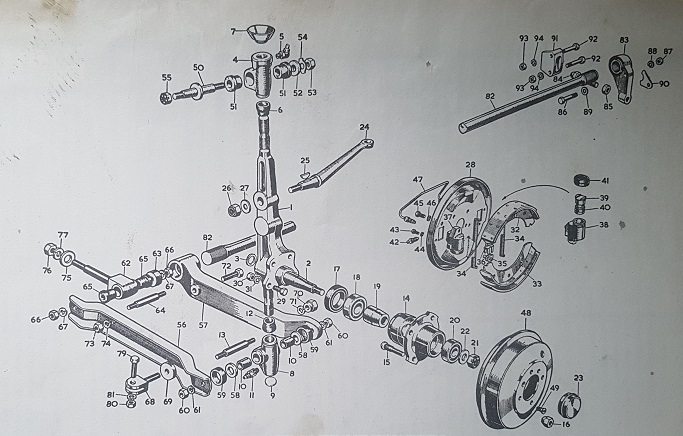
1. Kingpin and stub axle.
2. Stub axle.
3. Circlip.
4. Upper link.
5. Grease nipple for upper link.
6. Rubber seal.
7. Top plate.
8. Lower link.
9. Plug.
10. Bush.
11. Grease nipple for lower link.
12. Rubber seal.
13. Lower link fulcrum pin.
14. Hub assembly.
15. Wheel stud.
16. Nut for wheel stud.
17. Hub oil seal.
18. Inner bearing.
19. Bearing distance piece.
20. Outer bearing.
21. Nut-LH thread.
22. Washer for nut.
23. Cap.
24. Steering arm left hand.
25. Key to swivel pin.
26. Nut for swivel pin.
27. Washer for nut.
28. Brake plate left hand.
29. Brake plate to swivel pin bolt.
30. Nut for bolt.
31. Spring washer.
32. Brake shoe assembly.
33. Brake lining.
34. Shoe pull off spring.
35. Brake adjuster.
36. Mask adjuster.
37. Wheel cylinder LH.
38. Body LH.
39. Piston.
40. Taper seal.
41. Rubber boot.
42. Blead screw.
43. Wheel cylinder bolt SM.
44. Spring washer.
45. Wheel cylinder bolt LG.
46. Spring washer.
47. Bridge pipe.
48. Brake drum.
49. Screw-drum to hub.
50. Damper arm pivot bolt.
51. Rubber bush for upper link.
52. Washer for rear pivot.
53. Nut for rear pivot.
54. Tab washer for rear pivot.
55. Nut for front pivot.
56. Wishbone arm front.
57. Wishbone arm rear.
58. Thrust washer for link fulcrum pin.
59. Sealing ring for link fulcrum pin.
60. Nut for link fulcrum pin.
61. Spring washer.
62. Eye bolt.
63. Spigot pivot rear.
64. Fulcrum pin.
65. Rubber bush for eye bolt.
66. Nut.
67. Spring washer.
68. Wishbone fork.
69. Washer.
70. Fork nut.
71. Spring washer.
72. Bolt front to rear arm.
73. Nut.
74. Spring washer.
75. Eye bolt lock washer.
76. Nut.
77. Washer.
79. Anti roll bar to fork bolt.
80. Nut.
81. Spring washer.
82. Torsion bar.
83. Torsion bar lever.
84. Torsion bar adjuster.
85. Locknut.
86. Not used on Olympic.
87. Not used on Olympic.
88. Not used on Olympic.
89. Not used on Olympic.
90. Not used on Olympic.
91. Abutment bracket.
92. Bolt.
93. Nut.
94. Washer.